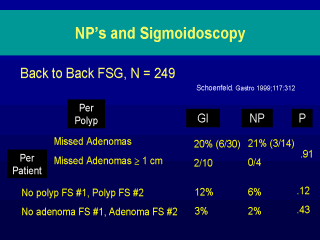 |
There have been some studies
looking at nurse practitioners. The model that’s currently out there is that a patient
will see his doctor, the doctor will order the flex sig, and then will perform it a few
weeks later on the patient in the doctor’s office. There are a lot of problems with that
model. Doctors are expensive. The PLCO trial is is a randomized study that was done where
they did back to back flex sig using GI doctors versus nurse practitioners, basically to
see how nurse practitioners performed. It’s a complicated slide. I would just look at
the per patient analysis. For “no polyp flex sig number one, polyp found in flex sig
number two,” you see there was a 12% incidence of that in the GI group. The nurse
practitioners found it a little less, although it wasn’t statistically significant. If
you look at adenoma rates, which, to me, is what’s important – no adenoma flex sig
one, adenoma flex sig two – you see the rates are absolutely equivalent. Nurse
practitioners can certainly do a very adequate job and that’s a way that we could
perhaps deliver the service to more people. |
